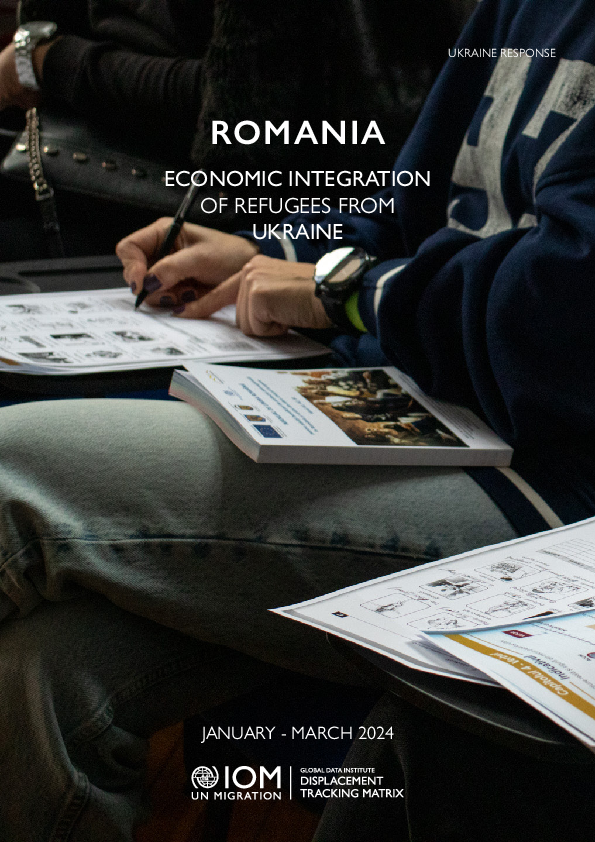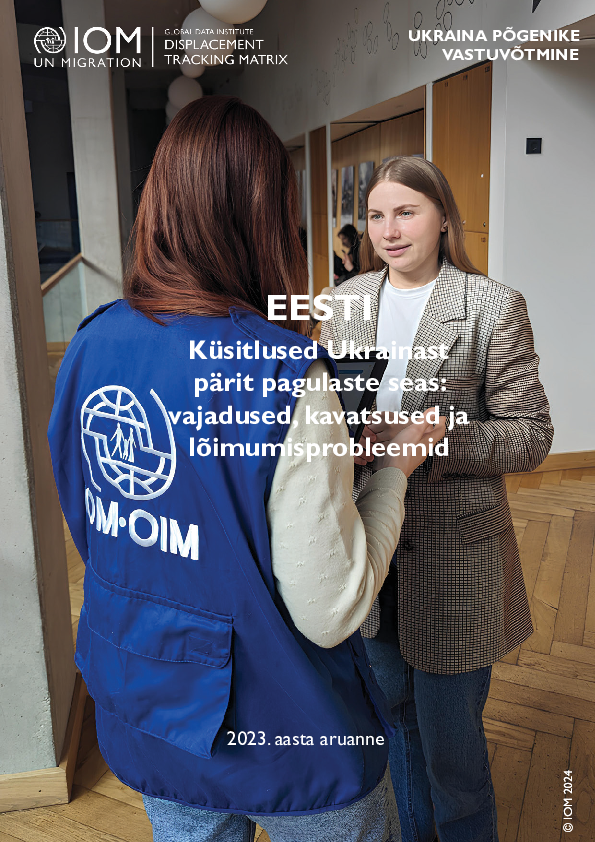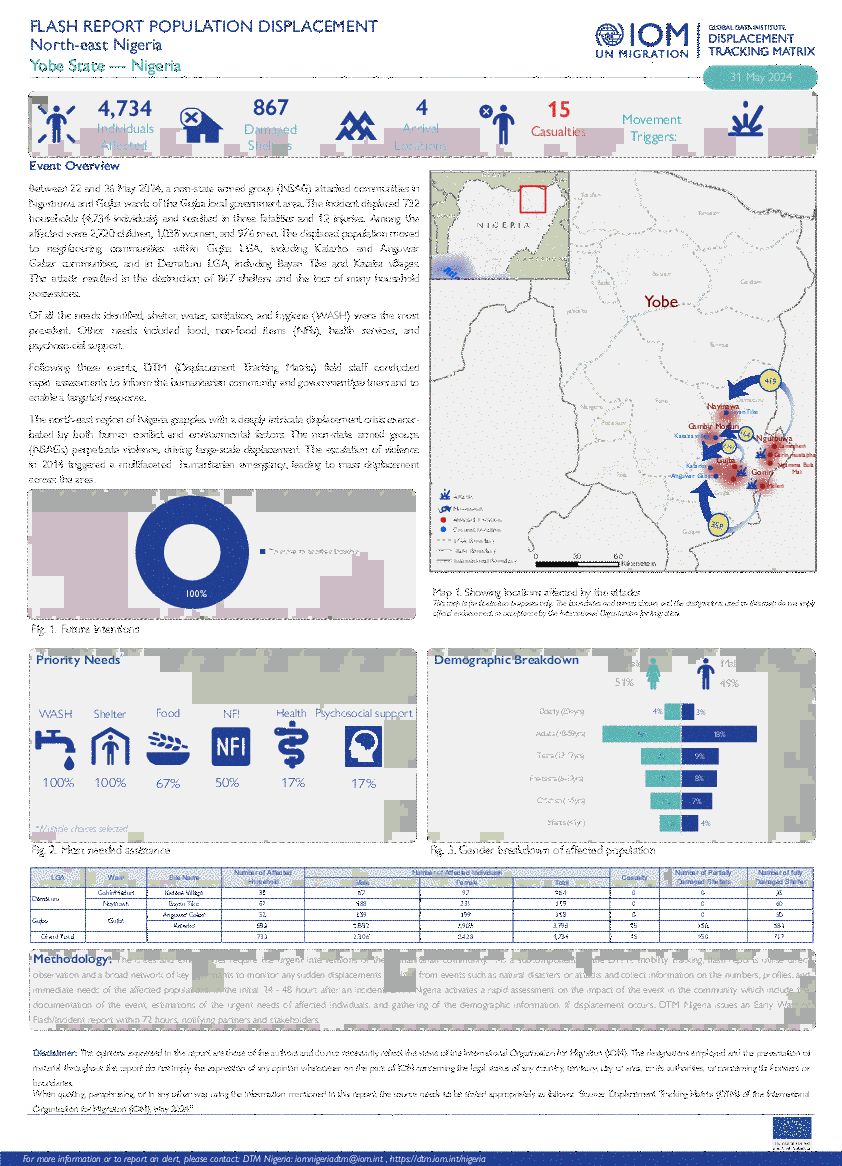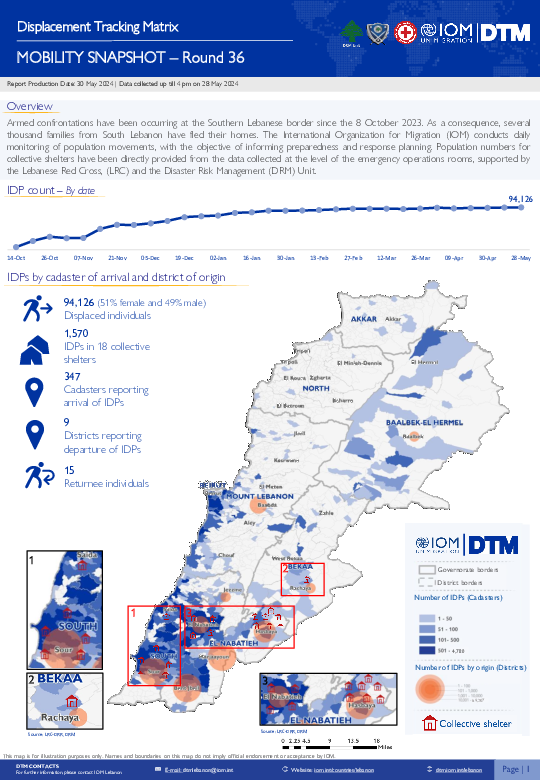-
Countries
-
Data and Analysis
-
Special Focus
-
Crisis Responses
Assessment Report

Contact
DTM Europe, DTMMediterranean@iom.int
Language
English
Location
Slovakia
Period Covered
Jan 01 2024
Mar 31 2024
Activity
- Survey
- Return Intention
- Flow Monitoring
IOM’s Displacement Tracking Matrix (DTM) collected data on Ukrainian nationals and Third-Country Nationals (TCNs) that crossed back to Ukraine from or through Slovakia, either temporarily or permanently. The survey focuses on the return intentions, duration of displacement, destinations, assistance, and experiences of discrimination of respondents. A total of 1,335 surveys were collected between January and March 2024.
Key findings:
- 27% of Ukrainian respondents intend to stay in Ukraine (prospective returnees), while 68% plan to go for a short visit.
- The share of those intending to return to Ukraine is higher among men than women (49% vs 25%). Women are more likely to be crossing into Ukraine for a short visit than men (69% vs 44%).
- Most of the short-term visitors plan to stay in their own home in Ukraine (78% overall), while others report to be going to their relatives’ homes (10%), finding other private solutions (7%) or staying with friends (4%). The share of those planning to stay at home is higher among prospective returnees (98%) than among short-term visitors (78%).
- Reasons for returning for prospective returnees include: visit relatives or close friends (75%), meet with family members (6%), reunite with their family (6%).
- Reasons for returning for short-term visitors include: visit family members (76%), healthcare (26%), reunite with family (21%).
- 64% of the Ukrainian nationals originate from seven regions in Ukraine: Zakarpatska (21%), Kyiv (13%), Kharkivska (8%), Dnipropetrovska (8%), Odeska (6%), Zaporizka (3%), and Mykolaivska (3%). The remaining 36% of respondents come from another 20 regions across Ukraine.

Contact
DTM Europe, DTMMediterranean@iom.int
Language
English
Location
Romania
Period Covered
Jan 01 2024
Mar 31 2024
Activity
- Survey
- Flow Monitoring
IOM’s Displacement Tracking Matrix (DTM) collected data through Surveys with Refugees in the Ukraine Response region from January to March 2024. This report focuses on the economic integration of the Ukrainian nationals residing in Romania since the start of the war in February 2022. The survey reported on the situation of 436 interviewed Ukrainian nationals, with a focus on the respondents of working age (18-64 years old).
Key findings:
- 60% of respondents were active in the labour market, while 35% were inactive and 5% were unknown
- Within the active population, 65% were employed and 35% were unemployed and looking for a job
- Most respondents utilised their personal network to find employment (43%). Others utilised: recruitment agencies (19%), social media (14%), job portals (11%).
- 43% of respondents had neutral feelings towards their job satisfaction
- Majority of respondents identified no problems at work (51%). For those who did, the main problems included: being underpaid (4%), having no contract (4%), working long hours (4%), and no breaks (3%).
- Top 3 sources for paying expenses included: family support (46%), income (41%), and savings (35%).

Contact
DTM Europe, DTMMediterranean@iom.int
Language
Estonian
Location
Estonia
Period Covered
Mar 01 2023
Dec 31 2023
Activity
- Survey
- Flow Monitoring
IOMi sundrände jälgimise maatriks on regulaarselt küsitlenud inimesi, kes elavad 11 riigis, mida hõlmab Ukraina piirkondliku pagulasküsimuse tegevuskava. Küsitluse eesmärk on parandada arusaamist nende profiilidest, sundrändemustritest, kavatsustest ja vajadustest. Küsitlust tehakse kuues Ukraina naaberriigis –Valgevenes, Ungaris, Poolas, Moldova Vabariigis, Rumeenias ja Slovakkias –ning viies teises Euroopa riigis, mida Ukrainast pärit pagulaste saabumine alates sõja algusest 2022. aasta veebruaris iseäranis mõjutab, sealhulgas Bulgaarias, Tšehhis, Eestis, Lätis ja Leedus.
Käesolevas aruandes esitatud analüüs põhineb 2023. aasta märtsist detsembrini kogutud iga-aastastel andmetel.

Contact
DTMAfghanistan@iom.int
Language
English
Location
Afghanistan
Period Covered
Jan 01 2023
Dec 31 2023
Activity
- Survey
Following the release of the first edition of PROGRESS 2023 report, the Displacement Tracking Matrix (DTM) has compiled a series of National Displacement Profiles based on end of year 2023 figures. These profiles offer insights into the latest end-of-year 2023 figures, aligning with the objectives outlined by the Data for Solutions to Internal Displacement Taskforce (DSID).
The profile provides a comprehensive overview of the demographic breakdowns and geographical distribution of internally displaced persons (IDPs) in Afghanistan as of the end of 2023. It delves into the primary areas of origin and displacement for IDPs, shedding light on the factors influencing their decision-making processes regarding the selection of solutions locations. Additionally, the report discusses the obstacles encountered by IDPs in their pursuit of durable solutions.
This compilation underscores the critical role of data in addressing internal displacement challenges and highlights the ongoing efforts to leverage data-driven solutions through collaborative initiatives like DSID.

Contact
DTM Sudan, DTMSudan@iom.int
Language
English
Location
Sudan
Period Covered
Apr 01 2024
May 31 2024
Activity
- Other
- Mobility Tracking
- Event Tracking
Since 01 April 2024, DTM monitored numerous clashes across Al Fasher and other localities in North Darfur state. According to DTM field teams, clashes triggered widespread displacement across North Darfur state. As of 31 May 2024, approximately 129,825 individuals (approximately 25,965 households) were displaced in Al Fasher locality due to the numerous clashes since 01 April 2024.
The Focused Flash Alert provides a numeric breakdown of population estimates affected by the recent escalations from 01 April -31 May 2024. All figures should be understood as preliminary estimates, pending further verification.
DTM Sudan releases Early Warning Flash Alerts to provide immediate updates on specific incidents or armed clashes that spurred displacement. Early Warning Flash Alerts are distributed via the DTM Sudan mailing list. For more information, see Focused Flash Alert North Darfur (Update 001).

Contact
iomnigeriadtm@iom.int
Language
English
Location
Nigeria
Period Covered
May 22 2024
May 26 2024
Activity
- Mobility Tracking
- Event Tracking
Between 22 and 26 May 2024, a non-state armed group (NSAG) attacked communities in Ngurbuwa and Gujba wards of the Gujba local government area. The incident displaced 732 households (4,734 individuals) and resulted in three fatalities and 12 injuries. Among the affected were 2,720 children, 1,038 women, and 976 men. The displaced population moved to neighbouring communities within Gujba LGA, including Katarko and Anguwar Gabar communities, and in Damaturu LGA, including Bayan Tike and Kasaisa villages. The attack resulted in the destruction of 867 shelters and the loss of many household possessions.
Of all the needs identified, shelter, water, sanitation, and hygiene (WASH) were the most prevalent. Other needs included food, non-food items (NFIs), health services, and psychosocial support.
Following these events, DTM (Displacement Tracking Matrix) field staff conducted rapid assessments to inform the humanitarian community and government/partners and to enable a targeted response.
The north-east region of Nigeria grapples with a deeply intricate displacement crisis exacerbated by both human conflict and environmental factors. The non-state armed groups (NSAGs) perpetuate violence, driving large-scale displacement. The escalation of violence in 2014 triggered a multifaceted humanitarian emergency, leading to mass displacement across the area.

Contact
DTMUkraine@iom.int
Language
English
Location
Ukraine
Period Covered
Mar 10 2024
Apr 11 2024
Activity
- Survey
Between 10 March and 11 April 2024, the International Organization for Migration (IOM) conducted Round 16 of the General Population Survey (GPS), a highly representative assessment of internal displacement in Ukraine. The data presented in this report was commissioned by the International Organization for Migration (IOM) and collected by 59 enumerators employed by Multicultural Insights through screener phone-based interviews with 20,000 randomly selected respondents and follow-up interviews with 1,428 IDPs, 1,639 returnees, and 2,266 residents, using the computer-assisted telephone interview (CATI) method, and a random digit dial (RDD) approach.
This report provides the main findings from Round 16 of the GPS, including detailed insights into population figures, displacement flows and mobility intentions, demographic profiles, household composition and vulnerabilities, and needs of the displaced population, to facilitate evidence-based decision-making on strategic, technical, and programmatic aspects of the response and recovery efforts in Ukraine.

Contact
dtmlebanon@iom.int
Language
English
Location
Lebanon
Period Covered
Oct 10 2023
May 28 2024
Activity
- Mobility Tracking
- Baseline Assessment
Since October 8 there has been an increase in cross-border incidents between Israel and Lebanon, resulting in the displacement of people both within the South and elsewhere within the country. Since October 10, the Displacement Tracking Matrix (DTM) has been conducting the daily monitoring of population movements. The objective of the exercise is to inform preparedness and response planning.

Contact
DTM Sudan, SudanDTM@iom.int
Language
English
Location
Sudan
Period Covered
May 08 2024
May 21 2024
Activity
- Other
Following the increase in localized displacement due to fires, DTM Sudan released the following report summarizing DTM updates on displacement due to fire incidents across Sudan, from 08 May to 21 May 2024.
DTM field teams reported five fire incidents across North Darfur (1), North Kordofan (2), White Nile (1), and Northern (1) states. Some fires were reportedly caused by increased temperatures and drier climate conditions, while others were due to household accidents.
Highlights
- Fires displaced an estimated 575 individuals (approximately 115 households) between 08 May and 21 May 2024.
- Over 133 structures (126 houses and seven farms) were destroyed or partially damaged by the fires.
- The fires resulted in localized displacement: the majority of displaced households sought shelter with host communities within the same locations.

Contact
DTM Europe, DTMMediterranean@iom.int
Language
English
Location
Bosnia & Herzegovina
Period Covered
Apr 01 2024
Apr 30 2024
Activity
- Flow Monitoring
This report provides insights into the profiles, experiences, needs, routes travelled and intentions of migrants transiting through Bosnia and Herzegovina (BiH). Data was collected from 1 to 30 April 2024. IOM carried out a route observation exercise in the Republika Srpska, Sarajevo Canton, Posavina Canton, Tuzla Canton, Bosnian-Podrinje Canton and Una Sana Canton to monitor trends in entries and exits as well as transit modalities within BiH. IOM also surveyed 553 migrants in active transit locations such as bus stops or at key entry and exit locations throughout the country as well as in four transit reception centres (TRCs) in BiH (Lipa, Ušivak, Borići and Blažuj).
Pagination
- Previous page
- Page 29
- Next page
